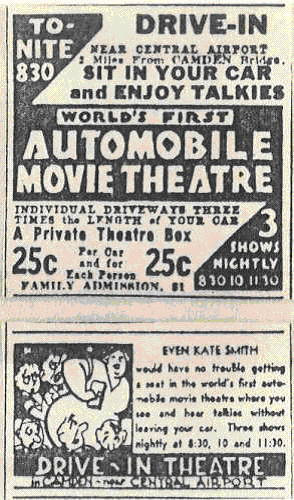Voices and Visions
This issue, devoted to sight and sound
in Whitman, Whitman Studies, and modern
American culture generally presents a range
of work related to the ways in which Whitman
has been seen and heard over the course
of two centuries in the U.S.
Whitman’s house on what was Mickle
Street (now Martin Luther King, Jr., Blvd)
in Camden was a place where sights and
sounds collided for Whitman, as he would
look out his first-floor window and watch
the flow of goods and people going down
to and coming back from the seaport. Later,
not long after Whitman’s death, RCA
built its headquarters just a few blocks
from Whitman’s house, and Camden
thus became the capital of sound recording
and of the manufacture of sound recording
technology. Some years later, in
1933, Camden became the first city in the
country to have a drive-in movie theatre,
synchronizing images and sound.
 |
|
The screen tower of the first drive-in at Camden, New Jersey, June 1933.
|
 Screen of the first drive-in. Photo from Tim Thompson's Drive-In Theater.com.
Screen of the first drive-in. Photo from Tim Thompson's Drive-In Theater.com.
taken June 1933 |
| Ads from Philadelphia's Public Ledger for the opening days of the first drive-in in the world at Camden, New Jersey. Photo from Kerry Segrave's book. Taken June 6th and 7th, 1933 |
|
In this special issue we make available
for the first time a wide range of spoken
word LPs featuring actors reading from Leaves
of Grass and educational videos about
aspects of Whitman’s life and writings. It
is hoped that this archive will be useful
to both scholars and teachers of Whitman
at all levels who are interested in issues
of performance and interpretation.
In keeping with this multimedia and hypermedia
emphasis, the articles, feature pieces,
poetry, and reviews published here address
in various ways Whitman’s performance
modalities and the sites, many of which
splice together sight and sound, in which
performances of his work took and take
place. Ed
Whitley contributes an article
reflecting on his work on the website The
Vault at Pfaff’s: An Archive of Art
and Literature by New York City’s
Nineteenth-Century Bohemians. Elizabeth
Lorang discusses the issues surrounding
the editing of Whitman’s journalistic
poetry for the publicly accessible Walt
Whitman Archive. John Tessitore
takes up the issue of the Boston banning
of the 1860 edition of Leaves of Grass and
Whitman’s connection to Free Religion,
putting into a more thorough historical
context how Whitman was seen and heard
by various factions in Boston during those
years.
Zoe
Trodd, who, like Whitley, places Whitman
in the milieu of nineteenth-century bohemianism,
takes care to place him in a longer tradition
of American protest literature, finding
that while “Whitman had sensed earlier
voices,” responding to them in his
work, others after Whitman “listened
back to Whitman’s voice.” She
points out that Whitman is read into and
read aloud at the scene of political protests,
especially those revolving around the gay
rights movement. Jason Stacy analyzes
Whitman’s attempts to negotiate early
consumerism while maintaining the ideals
of artisan republicanism and Hicksite Quakerism
in his exploration of labor and the nascent
consumer economy, locating in his early
journalistic performances a carefully crafted
sounding of public politics.
In feature pieces, the documentary filmmaker
Robert Emmons trains his eye on the Whitman
cartoons of Jeremy Eaton, which, he argues,
have much to tell us about American political
culture through their imagery. Geoffrey
Sill reveals for the first time a
recovered and restored photograph of Whitman
(or is it a photograph of a painting of
Whitman?) derived from one of his famous
sittings; and Michael
Robertson and David Haven Blake provide a useful blueprint,
based on experience, of a communal reading
of “Song of Myself.”
We also offer here, in the Documents section,
Jesse Merandy’s hypertext of “Crossing
Brooklyn Ferry,” a poem that is itself
about the links made between and among
people transhistorically. The poems
of Judith Baumel, Adam Bradford, and Kim
Roberts also help to situate Whitman in
the larger American scene, both during
his life and in death.
Finally, our two crack reviewers—Roberta
Tarbell and William
Pannapacker—weigh
in on Ruth Bohan’s book on Whitman
and visual art and Kenneth M. Price’s
investigation of Whitman and popular culture,
respectively.
Happy listening!
Tyler Hoffman, Editor |


